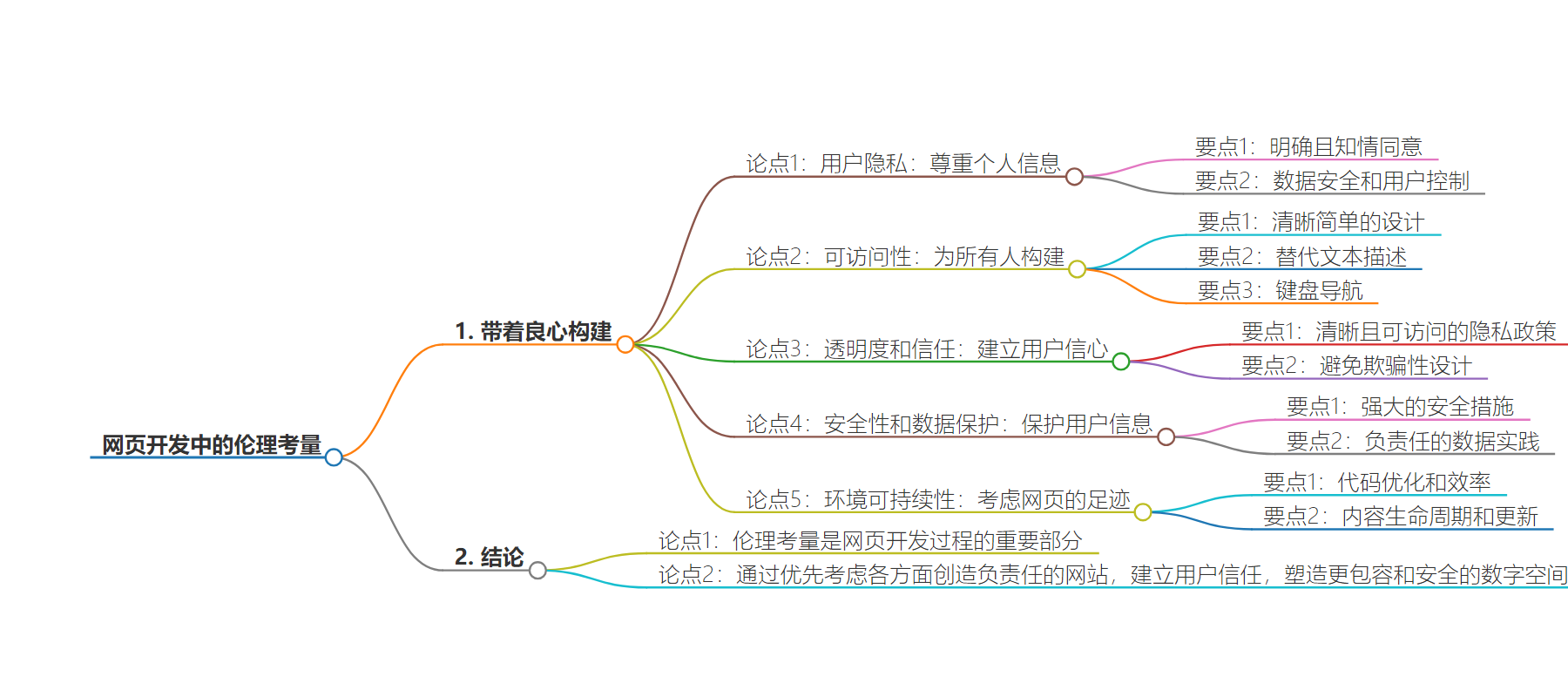包阅导读总结
1.
关键词:Web 开发、伦理考量、用户隐私、可访问性、可持续性
2.
总结:本文强调在数字时代,Web 开发中伦理考量至关重要,涵盖用户隐私、可访问性、透明度、安全和环境可持续性等方面,旨在创建功能良好、负责任且用户友好的网站。
3.
主要内容:
– 伦理考量在 Web 开发中至关重要
– 注重用户隐私
– 明确收集数据目的,获取用户同意
– 保障数据安全,给予用户控制权
– 确保可访问性
– 设计清晰简单
– 提供图像替代文本描述
– 支持键盘导航
– 保持透明度和信任
– 制定清晰易懂的隐私政策
– 避免欺骗性设计
– 加强安全和数据保护
– 采取强大安全措施
– 负责数据收集
– 考虑环境可持续性
– 优化代码提高效率
– 关注内容更新方式
思维导图:
文章地址:https://www.javacodegeeks.com/2024/07/ethical-considerations-in-web-development.html
文章来源:javacodegeeks.com
作者:Eleftheria Drosopoulou
发布时间:2024/7/4 11:30
语言:英文
总字数:876字
预计阅读时间:4分钟
评分:84分
标签:伦理考量,网站开发,隐私保护,数据安全,可访问性
以下为原文内容
本内容来源于用户推荐转载,旨在分享知识与观点,如有侵权请联系删除 联系邮箱 media@ilingban.com
In today’s digital age, where websites are the backbone of countless businesses and information sources, ethical considerations in web development become paramount. While developers focus on functionality and aesthetics, it’s crucial to consider the broader impact their creations have on users and society as a whole. This introduction will explore key ethical aspects of web development, guiding you to build websites that are not only functional but also responsible and user-centric. We’ll delve into principles like user privacy, accessibility, and responsible data collection, ensuring your web development practices are ethical and contribute to a positive online experience for everyone.
1. Building with a Conscience
The web has become an essential part of our lives, and the code that powers websites shapes our online experiences in profound ways. But beyond functionality and aesthetics, ethical considerations are crucial in web development. Here, we’ll explore some key aspects to ensure your websites are not only effective but also responsible and user-centric:
1. User Privacy: Respecting Personal Information
In today’s data-driven world, protecting user privacy is paramount. This means treating user information with respect and ensuring its responsible collection and use. Here’s what it looks like in practice:
- Clear and Informed Consent: Before collecting any user data, obtain explicit consent. Explain what information is being gathered, how it will be used, and provide users with the option to opt-out. Imagine a news website offering personalized content recommendations. They might ask users for their preferred topics upon registration, but clearly state that this information is solely for personalization and won’t be shared with third parties.
- Data Security and User Control: Implement robust security measures to safeguard user information from unauthorized access or breaches. Store data securely, encrypt sensitive details, and offer users control over their information. This might involve allowing users to access, update, or delete their data whenever they choose.
2. Accessibility: Building for Everyone
The web should be a welcoming space for everyone, regardless of ability. Accessibility in web development means ensuring websites are usable by people with disabilities, including those with visual impairments, hearing difficulties, or motor limitations. Here’s how to achieve this:
- Clear and Simple Design: Use clear and concise language, avoid jargon, and structure content logically. Incorporate headings and subheadings to break down information and make it easier to navigate.
- Alternative Text Descriptions: For images, provide accurate and descriptive alt text that conveys the image’s meaning for users who rely on screen readers. This allows visually impaired users to understand the context of the image.
- Keyboard Navigation: Don’t rely solely on mouse interaction. Ensure users can navigate the website using just their keyboard, making it accessible for people with motor limitations or who use screen readers.
3. Transparency and Trust: Building User Confidence
Building trust with users goes hand-in-hand with transparency. This means being upfront about how your website operates and what data you collect. Here’s how to cultivate a trustworthy online environment:
- Clear and Accessible Privacy Policies: Have a clear and easily accessible privacy policy that explains what data your website collects, how it’s used, and with whom it might be shared. Avoid legalese and write the policy in plain language that users can understand.
- Avoiding Deceptive Design: Refrain from using deceptive design elements or “dark patterns” that manipulate users into unwanted actions. For example, don’t make it difficult for users to unsubscribe from email lists or hide essential information behind multiple clicks.
4. Security and Data Protection: Safeguarding User Information
With the constant threat of cyberattacks, protecting user data is essential. Building a secure website goes beyond simply keeping user information confidential. Here’s how to ensure a safe online environment:
- Robust Security Measures: Implement strong security practices to protect user data from unauthorized access or breaches. This includes using secure coding practices, regularly updating software and plugins, and encrypting sensitive data like passwords and credit card information.
- Responsible Data Practices: Collect only the data you truly need for your website’s functionality and be clear about the purpose of data collection. Avoid collecting unnecessary personal information or storing data for longer than required. Remember, the less data you collect, the less vulnerable it is to potential breaches.
5. Environmental Sustainability: Considering the Web’s Footprint
While often overlooked, web development choices can have environmental consequences. Here’s how to create websites with a lighter footprint:
- Code Optimization and Efficiency: Strive for clean and efficient code that loads quickly. This reduces the energy consumption required to display your website and contributes to a more sustainable web infrastructure.
- Content Life Cycle and Updates: Consider the environmental impact of website content. Prioritize website updates over complete redesigns whenever possible. Evaluate the need for high-resolution visuals and explore alternative formats that might be lighter and faster loading.
By keeping these sustainability considerations in mind, you can contribute to a more environmentally responsible web development practice.
Conclusion
n conclusion, ethical considerations are no longer an afterthought in web development – they’re an essential part of the process. By prioritizing user privacy, accessibility, transparency, security, and even environmental impact, you can create websites that are not only effective but also responsible and contribute to a positive online experience for everyone. Ethical web development is about building trust with users and shaping a more inclusive and secure digital space.
